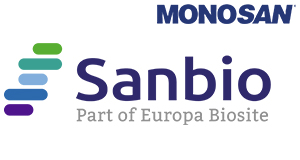Mouse anti-MAP3K1, clone EBS-T-008 (Monoclonal)
Mouse anti-MAP3K1, clone EBS-T-008 (Monoclonal)
Artikelnummer
SANMON9917
Verpackungseinheit
100 ug
Hersteller
Sanbio / Monosan
Verfügbarkeit:
wird geladen...
Preis wird geladen...
Clone Number: EBS-T-008
Immunogen: partial recombinant MAP3K1 (aa1211-1310)
Concentration: 100 ug/ml
Storage buffer: PBS with 0.02% sodium azide
Additional info: MAPKs are involved in directing cellular responses to a diverse array of potentially harmful stimuli, such as mitogens, osmotic stress, heat shock, proinflammatory cytokines, but also growth factors (mammals). Possibly located exclusively in the cell nucleus, they regulate cell functions including proliferation, gene expression, differentiation, mitosis, cell survival, and apoptosis. In order to become active, they require usually multiple phosphorylation events in their activation loops, including phosphorylation by MAP2 kinases (Ste-7 kinases), which in turn are phosphorylated by the MAP3 kinase family, of which many are located at the cell membrane. Thus through this pathway, stimuli can effectively be conveyed from the cell membrane to the nucleus. Inactivation of MAPKs takes place by several phosphorylases, including dedicated phophorylases.
Applications: ELISA, FC, IHC-fr, IHC-P, IF, WB
References: Guan, KL. et al, Cell. Signal. 6: 581-589 (1994)
Immunogen: partial recombinant MAP3K1 (aa1211-1310)
Concentration: 100 ug/ml
Storage buffer: PBS with 0.02% sodium azide
Additional info: MAPKs are involved in directing cellular responses to a diverse array of potentially harmful stimuli, such as mitogens, osmotic stress, heat shock, proinflammatory cytokines, but also growth factors (mammals). Possibly located exclusively in the cell nucleus, they regulate cell functions including proliferation, gene expression, differentiation, mitosis, cell survival, and apoptosis. In order to become active, they require usually multiple phosphorylation events in their activation loops, including phosphorylation by MAP2 kinases (Ste-7 kinases), which in turn are phosphorylated by the MAP3 kinase family, of which many are located at the cell membrane. Thus through this pathway, stimuli can effectively be conveyed from the cell membrane to the nucleus. Inactivation of MAPKs takes place by several phosphorylases, including dedicated phophorylases.
Applications: ELISA, FC, IHC-fr, IHC-P, IF, WB
References: Guan, KL. et al, Cell. Signal. 6: 581-589 (1994)
| Artikelnummer | SANMON9917 |
|---|---|
| Hersteller | Sanbio / Monosan |
| Hersteller Artikelnummer | MON9917 |
| Verpackungseinheit | 100 ug |
| Mengeneinheit | STK |
| Reaktivität | Human |
| Klonalität | Monoclonal |
| Methode | Immunofluorescence, Immunohistochemistry (frozen), Immunohistochemistry (paraffin), Western Blotting, ELISA, Flow Cytometry |
| Isotyp | IgG2a-k |
| Wirt | Mouse |
| Konjugat | Unconjugated |
| Produktinformation (PDF) | Download |
| MSDS (PDF) |
|

 English
English







